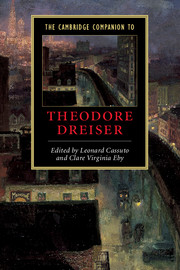3 - Dreiser’s style
from Part I - Backgrounds and contexts
Published online by Cambridge University Press: 28 May 2006
Summary
Although the question of Dreiser’s style is a complex one, involving considerations of ethnicity as well as aesthetics, to critics of the Cold War generation the very notion of analyzing Dreiser’s formal skills appeared a flat contradiction in terms. Lionel Trilling’s famous discussion of Dreiser in The Liberal Imagination (1950), where he declared that Dreiser “writes badly” and “thinks stupidly,” set the tone within the post-war American academy for the institutionalization of Henry James as a writer of the highest artistic “quality” and the downgrading of Dreiser as a sympathizer with the Communist Party who lacked “flexibility of mind.” Trilling charged Dreiser not only with “vulgar materialism” and a “doctrinaire anti-Semitism,” but also, when he did address the question of style, with a tendency toward “bookishness.” In phrases such as “a scene more distingué than this,” argued Trilling, Dreiser’s style is “precisely literary in the bad sense; he is full of flowers of rhetoric and shines with paste gems.”
In his view of Dreiser’s rhetorical inauthenticity, Trilling was explicitly taking exception to what he described as F. O. Matthiessen’s acquiescence in “the liberal cliché which opposes crude experience to mind.” Dreiser had been the subject of Matthiessen’s last book, published posthumously in 1951, which, in its portrayal of Dreiser as a forerunner of Popular Front socialism, can be understood as the final installment of Matthiessen’s effort, begun in American Renaissance (1941), to align American literary culture with a progressive, communitarian spirit.
- Type
- Chapter
- Information
- The Cambridge Companion to Theodore Dreiser , pp. 47 - 62Publisher: Cambridge University PressPrint publication year: 2004
- 3
- Cited by



